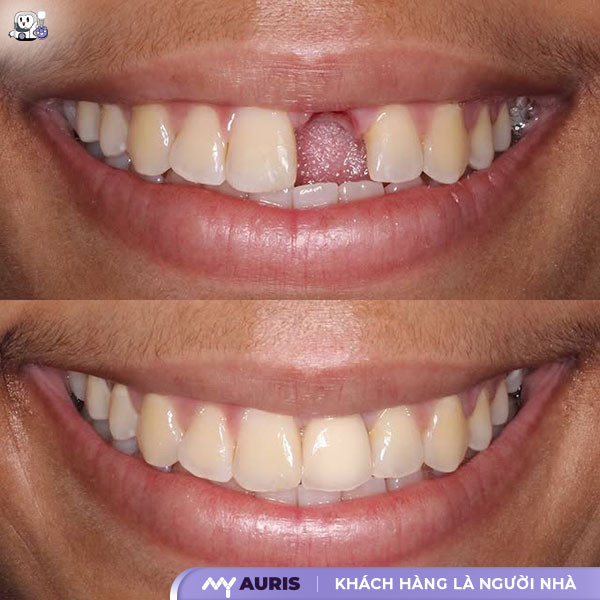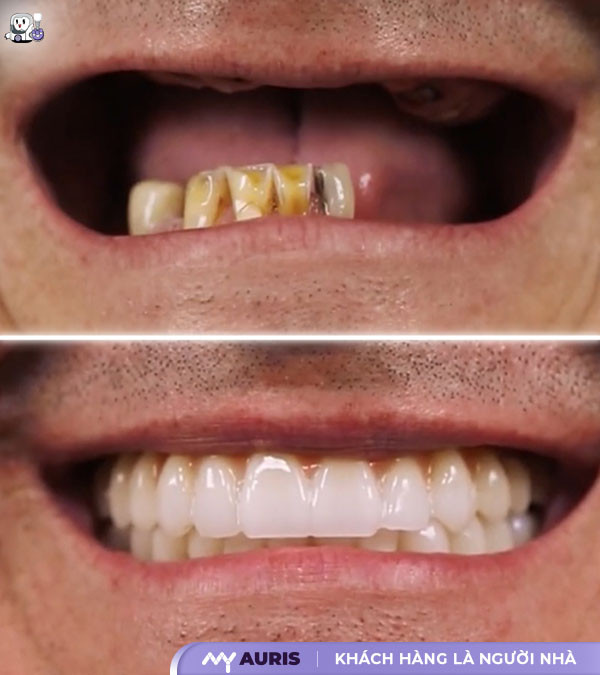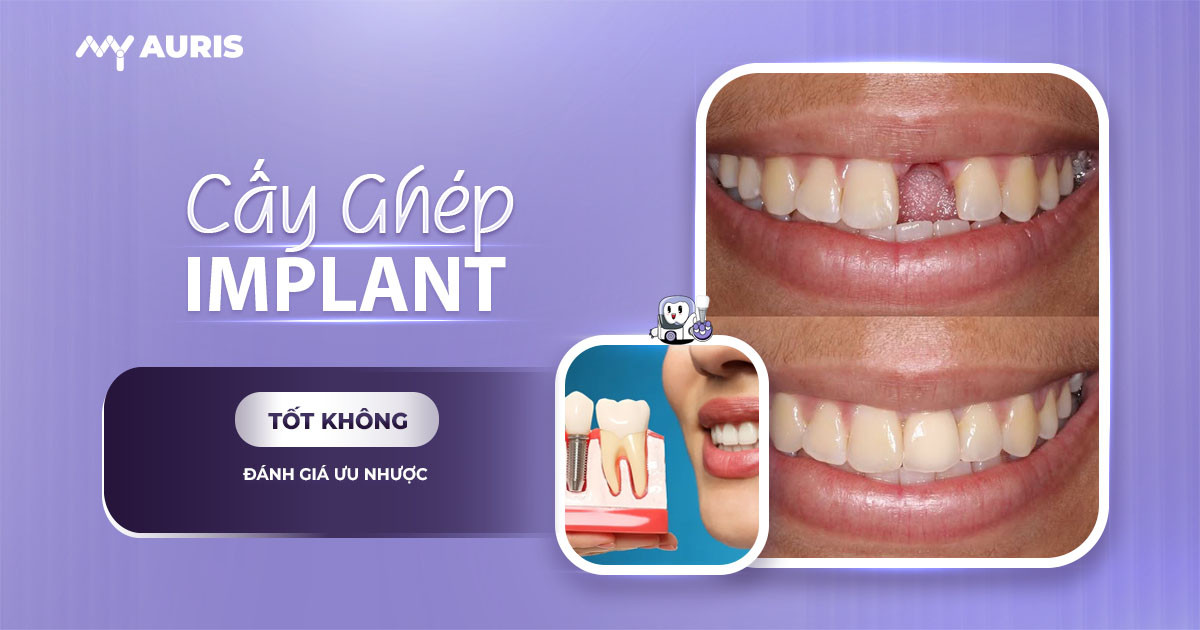Implant placement is an optimal tooth restoration solution with a structure similar to natural teeth. But is this method truly suitable? This article provides a detailed analysis of the pros and cons of dental implants, helping you make an informed decision.
What is Implant placement?
Implant placement is a modern dental surgical procedure used to restore lost teeth, whether it’s a single tooth or multiple teeth. This technique involves placing an implant post (artificial tooth root) into the jawbone, replacing the lost natural tooth root. Subsequently, a porcelain crown is permanently attached to the post via an abutment, forming a complete tooth.
The structure of a tooth restored with implant techniques closely resembles a natural tooth, providing comfortable chewing sensation and ensuring high aesthetics. This solution is widely trusted at reputable dental centers due to its long-term effectiveness in tooth restoration, improving oral health, and preventing jawbone loss.
The duration for implant placement and completing a full dental implant procedure typically ranges from 1 to 3 months, depending on the jawbone condition and the patient’s overall health.

Is implant placement good?
Implant placement is a modern restorative dental solution, highly valued for its numerous outstanding advantages, making it suitable for those seeking a safe and long-lasting solution for tooth loss.
Prevents gum recession and jawbone loss: After tooth loss, without proper dental intervention, the jawbone will gradually resorb due to lack of chewing activity. Traditional methods like dental bridges cannot stimulate the bone, leading to gum recession and jawbone loss. In contrast, dental implants mimic the structure of natural teeth, helping maintain natural chewing function and effectively preventing bone resorption.
Does not affect natural teeth, prevents misalignment: Unlike methods that use adjacent teeth as abutments, implant placement only intervenes in the area of the lost tooth, preserving the structure of the remaining natural teeth and preventing tooth misalignment.
Extends prosthetic tooth lifespan: By being firmly embedded in the jawbone, implants offer high durability. With proper care, implant-supported teeth can last for several decades.
Maximizes chewing function restoration: Excellent load-bearing capacity allows implant-supported teeth to function almost like natural teeth. Patients do not experience the bulkiness or discomfort during eating that is common with conventional removable dentures.
High aesthetics, natural like real teeth: Implant-supported teeth are designed to match each individual’s tooth size and jaw structure. The similarity in color and shape helps restore the natural appearance of the dentition, supports harmonious facial muscles, and helps patients communicate more confidently.

Disadvantages of dental implant placement method
Dental implant placement is considered an effective solution for restoring lost teeth; however, some disadvantages need to be noted.
Firstly, this is a complex technique that requires execution by experienced and well-trained specialists. If expertise and strict procedures are not ensured, it can lead to numerous post-treatment complications.
Regarding cost, dental implant placement typically has a higher cost compared to traditional options. The price of an implant can vary depending on the implant material used and the accompanying technology.
Another limitation is the age restriction; this technique is not applicable to patients under 16 years old, as their jawbone structure has not yet fully developed.
Furthermore, the extended treatment time is also a significant inconvenience. An implant procedure can take from several weeks to several months, including the osseointegration phase of the implant post with the jawbone and the final prosthetic restoration.
Implant Placement Procedure
Below is the standard implant placement procedure, helping you clearly visualize and be more proactive in your treatment:
General Examination and Clinical Assessment
The dentist will perform a general examination of your oral health, take dental X-rays or CT Cone Beam scans to assess jawbone density and height. If there are signs of periodontitis, tooth decay, or related pathologies, these must be thoroughly treated before proceeding with dental surgery.
Personalized Treatment Planning
Based on the examination results, the dentist will create a personalized dental implant treatment plan, which includes:
- Implant placement location
- Appropriate implant post size and type
- Whether bone grafting is needed
- Porcelain crown restoration roadmap
A clear plan helps increase the success rate and ensures long-term chewing function and aesthetics.
Implant Post Placement Phase into the Jawbone
This is a minor dental surgery performed under local anesthesia to minimize pain. The dentist uses specialized instruments to place the titanium implant post into the missing tooth’s position. This process takes approximately 20–30 minutes per post. Implants have high biocompatibility and integrate well with the jawbone.
After surgery, the patient rests in the clinic for about 30 minutes. The dentist will prescribe painkillers, antibiotics, and provide detailed instructions for at-home oral care.
Healing and Osseointegration Phase
The implant post requires 6–12 weeks for biological integration with the jawbone. During this time, you will need to have regular follow-up appointments to check the healing progress, adhere to a soft diet, and maintain proper oral hygiene.
With modern implant technology, the integration time can be shortened due to extremely high chewing force resistance and durability.
Abutment and Porcelain Crown Placement
After the post has fully integrated, the dentist will attach the abutment (the connector between the post and the crown) and take impressions to fabricate the aesthetic porcelain crown. The porcelain crown is securely fixed, restoring chewing function and appearance like a natural tooth. Immediate loading may be possible if the jawbone conditions are suitable.
Regular Follow-ups and Post-Restoration Care
After completion, patients need to have follow-up appointments every 6 months to check the stability of the implant. The dentist will provide instructions on post-implant oral care: proper brushing, flossing, limiting hard foods, and avoiding smoking.
Is implant placement painful?
Implant placement is a minor dental surgery. Before performing the procedure, the dentist will administer local anesthesia using specialized dental anesthetics. Patients typically feel almost no pain during the procedure. The entire process of placing the implant post into the jawbone takes only 20 to 30 minutes with modern dental technology.
After surgery, mild soreness or swelling may occur for 1–3 days. This is a normal bodily reaction to receiving new implant material. Pain is effectively managed with prescribed painkillers and post-implant oral care instructions. If done correctly, patients typically do not experience prolonged discomfort.

Important Notes for Dental Implant Placement
Although dental implant placement is a modern restorative method trusted by many, some implant complications can still arise if the procedure is not performed correctly or if post-operative care is inadequate:
Infection in the implant area and peri-implantitis: This is a common complication, often occurring due to insufficient oral hygiene, which creates conditions for bacterial growth. Symptoms include swelling, redness around the implant site, and prolonged pain.
Prolonged bleeding after surgery: Mild bleeding for 1-2 days after implant placement is normal. However, if bleeding is continuous and does not subside, the patient should contact their dentist immediately for prompt intervention.
Damage to adjacent tissues: Without proper jawbone imaging and precise planning, the implant procedure can cause damage to the inferior alveolar nerve, affecting sensation, or damage to the jawbone, leading to prolonged pain.
Implant misplaced: Incorrect implant placement can cause pain when chewing, uneven chewing forces, and in the long run, may lead to implant fracture, affecting the restoration’s effectiveness and oral aesthetics.
Is implant placement good and safe? According to restorative dental specialists, this is a safe method that does not affect health if performed correctly. However, to avoid complications, patients need to choose a reputable clinic with experienced dentists. The quality of the implant, sterilization procedures, and post-operative care play crucial roles in the success of the treatment.





